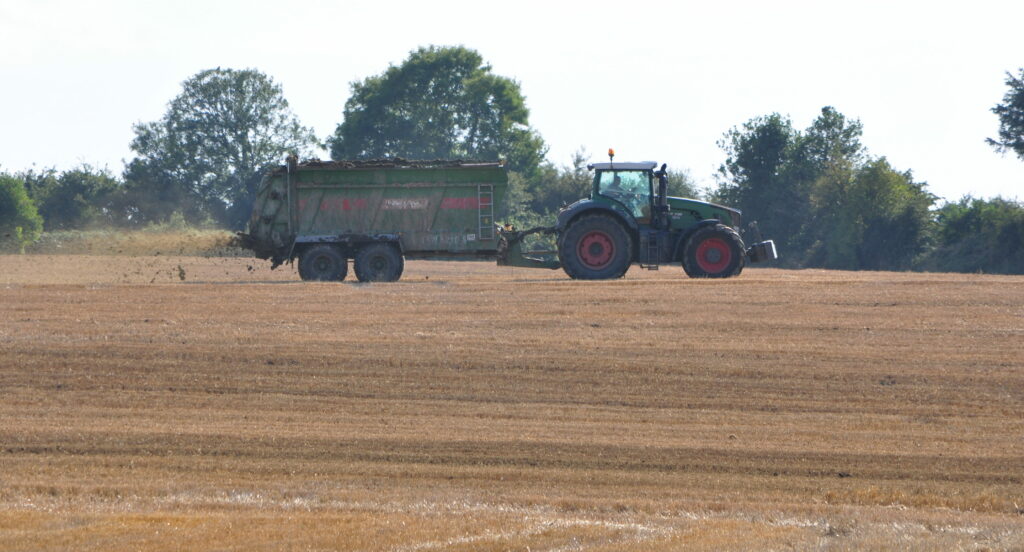Using organic manures on your tillage farm isn’t as simple as just spreading and incorporating.
Dermot Forristal outlined some of the challenges farmers can face when using organic manures at the Irish Tillage and Land Use Society’s (ITLUS) Winter Conference last week.
Organic manures can benefit your soil, but farmers need to be careful when applying and take note of the trafficability of the soil, as well as things like tyre size and pressure to avoid compaction.
Time of use
Dermot explained that handling organic manures isn’t simple. The timing of their use and the need to incorporate these manures promptly after spreading – in order to secure as much of the nutrients as possible – is one of the biggest challenges which farmers face.
Trials on pig slurry incorporation at Teagasc showed some of the effects of the time of incorporation.
“When you measured nitrogen after immediate incorporation, 57% of the nitrogen that was in the slurry was recovered. If incorporation was delayed by two to three days, this figure was reduced to 32%. Hence, the reason for quick incorporation.”
- Cattle slurry – within two hours;
- Farmyard manure – less than two hours, but little available nitrogen at risk;
- Poultry manure – within six hours.
Dermot added that where liquid products are not being incorporated (for example they might be applied to the growing plant), they should be applied with low-emission spreading equipment.
He added that it’s important to recover as much of the nitrogen as possible in order to make the most of the nutrient availability figures in nitrates legislation.
Logistics
Logistics can have a big impact on the cost of these manures. Farmers must first of all have adequate storage for these organic manures, which may add to cost.
Apart from this, distance will have a big impact on cost. Dermot described how this can affect the bottom line.
The one thing to say is that transporting water is expensive and this is the big challenge that hits us on slurry or organic manures, particularly where the source is distant from the farm.
“If you have a bulk fertiliser spreader for ordinary fertiliser – an N, P, K product – that carries 10t, the value of the fertiliser in that load is €3,500 [estimate], so the distance you bring it isn’t going to have a huge impact on that.
If you take a tanker with 10t of cattle slurry – a 2,200 gallon tanker – the value of that load in terms of available N, P, and K is only €44/load.
“If you’re dealing with cattle slurry – which has a low value – and you’re transporting cattle slurry beyond 20km – the cost of transport is more than the value of the nutrients. Whereas, with the drier products you might be able to go 50km on a tractor.
It just shows you the challenge that’s there in terms of transporting these products.
Protecting the soil
Organic manures can add value to your soil, but care must be taken when spreading and incorporating these products.
Dermot explained: “Because you’re applying these products at a wet time, the critical factor is soil moisture. Wet soil is prone to damage from heavy machinery.”
Dermot added that machinery might travel better in a minimum-tillage situation, but farmers still need to protect the soil from damage. Dissipating tyre pressure doesn’t get rid of all of the harm of heavy-axle loads in some cases.
If you’re trying to put it on in advance of spring sowing, often you’re tempted to go at times when the soil’s bearing capacity isn’t brilliant, and of course the capacity of the machinery impacts on that timing as well.
“Tankers or anything that’s carrying loads need big tyres. If you take a single-axle recessed wheel tanker (2,500 gallon tanker) all up, it’s weighing over 15-12t on the axle; 6t/tyre.
“Even with the biggest of tyres – 30.5X32 – on that tanker it still requires an inflation pressure of 2 bar (or 2 bar plus) – that’s about 32 PSI.
“I would say the target for late-winter / early-spring application would be to have tyres big enough to run at 0.8-1 bar pressure,” Dermot added.

